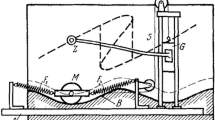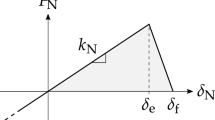Abstract
This paper presents a theoretical model for (dry, low-velocity, wear-less) friction force dynamics based on asperity interaction considerations subject to the phenomenological mechanisms of creep/relaxation, adhesion and (elasto-plastic) deformation in their most generalized forms. The model simulates the interaction of a large population of idealized, randomly distributed asperities with arbitrarily chosen geometrical and elastic properties. Creep and adhesion are simulated by an expedient local coefficient of friction that increases with time of contact, while deformation effects are accounted for by rate-independent hysteresis losses occurring in the bulk of the material of an asperity that is breaking loose. An energy method is adopted to calculate the instantaneous, local friction force leading to better insight into the problem as well as higher numerical efficiency. The results obtained by this model show both qualitative and quantitative agreement with the known types and facets of friction force dynamic behaviour; in particular, pre-sliding quasi time-independent frictional hysteresis in the displacement, velocity weakening, slider “lift-up” effect and frictional lag, in addition to the influence of the various process parameters, all in a single formulation, such as no extant friction model could show before. Moreover, the model is still open for and capable of further refinement and elaboration so as to incorporate local inertia and viscous effects and thus to be extended to include velocity strengthening and lubricated rough contacts.
Similar content being viewed by others
References
H. Spikes, Tribol. Int 34(12) (2001) 789.
B. Feeny, A. Guran, N. Hinrichs and K. Popp, Appl. Mech. Rev. 51(5) 321.
C.H. Holz, Nature 391 (1998) 37.
B.N.J. Persson, Sliding Friction: Physical Principles and Applications (Springer, Heidelberg, 1998).
B. Armstrong-Hèlouvry, D. Dupont and C. Canudas de Wit, Automatica 30(7) (1994) 1083.
J.R. Rice and A.L. Ruina, Trans. ASME, J. Appl. Mech. 50 (1983) 343.
J.T. Oden and J.A.C. Martins, Comp. Meth. Appl. Mech. Engng. 52 (1985) 527.
P.R. Dahl, Proceedings of 6th Annual Symp. on Incremental Motion, Control Systems and Devices (1977), p. 49.
T. Prajogo, Experimental Study of Pre-rolling Friction for Motion-reversal Error Compensation on Machine Tool Drive Systems (Katholieke Universiteit Leuven, Leuven, 1999).
S. Björklund, Trans. ASME J. Tribol. 119 (1997) 726.
D.A. Hills, D. Nowell and A. Sackfield, Mechanics of Elastic Contacts (Butterworth Heinemann, 1993)
B.J. Lazan, Damping of Materials and Members in Structural Mechanics (Pergamon Press, London, 1968).
D.A. Haessig,Jr. and B. Friedland, Trans. ASME, J. Dyn. Syst. Meas. Cont. (113) (1991) 354.
D.P. Hess and A. Soom, J. Tribol. (112) (1990) 147.
C. Canudas de Wit, H. Olsson, K. Aström and P. Lischinsky, IEEE Trans Auto. Cont. 40(5) (1995) 419.
J. Swevers, F. Al-Bender, C. Ganseman and T. Prajogo, IEEE Trans. Auto. Cont. 45(4) (2000) 675.
V. Lampaert, J. Swevers and F. Al-Bender, IEEE Trans. Auto. Cont. 47(4) (2002) 683.
B. Bhushan, (ed.). Handbook of Micro/Nano Tribology (2nd ed.) (CRC Press LLC, Boca Raton, 1999).
F.D. Bowden and D. Tabor, The Friction and Lubrication of Solids, Part I. (Clarendon Press, Oxford, 1950).
F.D. Bowden and D. Tabor, The Friction and Lubrication of Solids, Part II. (Clarendon Press, Oxford, 1964).
C.M. Edwards and J. Halling, J. Mech. Engng Sci. 10 (1968) 101.
G.A. Tomlinson, Philos. Mag. Ser. 7(7) (1929) 905.
M. Antler, Wear, 7 (1964) 181.
T. Baumberger, Phys. Sliding Fric. 1–16 (1996).
N.V. Gitis and L. Volpe, J. Phys. D: Appl. Phys. 25 (1992) 605.
H. Czichos, Tribology, A System Approach to the Science and Technology of Friction, Lubrication and Wear (2nd ed.) (Elsevier, Amsterdam, 1979).
K.N. Smith, P. Watson and T.H. Topper, J. Mater. JMLSA 5(4) (1970) 767.
J.A. Greenwood and J.B.P. Williamson, Roy. Soc. Proc.: Series A., 295 (1966) 300.
D. Dowson, History of Tribology (2nd ed.) (Professional Engineering London, London, 1998).
P.F. Rogers and G. Boothroyd, Trans. ASME, J. Eng. Ind. (1975) 1087.
S. Futami, A. Furutani and S. Yoshida, Nanotechnology 1(1) (1990) 31.
E. Rabinowicz, J. Appl. Phys. 22(11) (1951) 1373.
D.M. Tolstoi, Wear 10 (1967) 199.
R.V. Kappagantu and B.F. Feeny, Series Stability, Vibration Control Systems: Series B, 14 (1998) 167.
S. Kato, K. Yamaguchi and T. Matsubayashi, Trans ASME, J. Eng. Ind., (1974) 557.
J. Kosterin, Mechanical Oscillations in Dry Friction (Soviet Academy of Science, Moscow, 1960).
B. Derjaguin, V. Push and D. Tolstoi, Sov. J. Tech. Phys. (26) (1956) 1329.
E. Rabinowicz, Proc. Phys. Soc. (71) (1958) 668.
K. Okamura, T. Matsubara, S. Noro and T. Yamane, J. Jap. Soc. Prec. Eng. (34) (1968) 31.
P. Berthoud, T. Baumberger, C. G'Shell and J.-M. Hiver, Phys. Rev. B, 59(22) (1999) 14313.
Halling, J. (ed.), Principles of Tribology (Macmillan, London, 1979).
V. Lampaert, F. Al-Bender and J. Swevers, Trib. Lett. 16 (2004) 95.
Author information
Authors and Affiliations
Corresponding author
Rights and permissions
About this article
Cite this article
Al-Bender, F., Lampaert, V. & Swevers, J. A Novel Generic Model at Asperity Level for Dry Friction Force Dynamics. Tribology Letters 16, 81–93 (2004). https://doi.org/10.1023/B:TRIL.0000009718.60501.74
Issue Date:
DOI: https://doi.org/10.1023/B:TRIL.0000009718.60501.74




